1-4 The Sun appears to change position over the day and throughout the year, and these changes result in Earth’s seasons
As we travel with Earth around the Sun, we experience an annual cycle of seasons. But why are there seasons? Furthermore, the seasons are opposite in the northern and southern hemispheres. For example, February is midwinter in North America but midsummer in Australia. Why is this?
The Origin of the Seasons
The reason why we have seasons, and why they are different in different hemispheres, is that Earth’s rotation axis is not perpendicular to the plane of Earth’s orbit—in other words, Earth’s axis does not appear to be straight up and down but tipped to one side. As Figure 1-14 shows, Earth’s rotational axis is tilted about 23½° away to the side. Earth maintains this tilt toward the north celestial pole as it orbits the Sun.
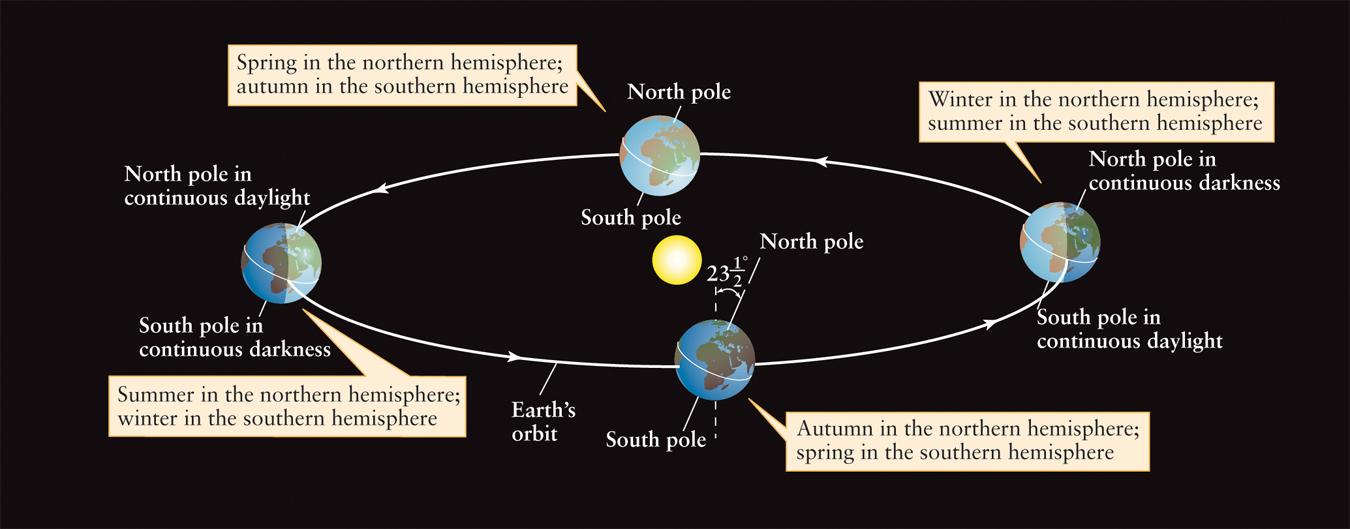
During part of the year, when Earth is in the part of its orbit shown on the left side of Figure 1-14, the northern hemisphere is tilted toward the Sun. As Earth spins on its axis, a point in the northern hemisphere spends more than 12 hours in the sunlight. Thus, the days there are long and the nights are short, and it is summer in the northern hemisphere. The summer is hot not only because of the extended daylight hours but also because the Sun is high in the northern hemisphere’s sky. As a result, sunlight strikes the ground from a point near overhead that heats the ground efficiently (Figure 1-15a). During this same time of year in the southern hemisphere, the days are short and the nights are long, because a point in this hemisphere spends fewer than 12 hours a day in the sunlight. The Sun is low in the sky, so sunlight strikes the surface at a grazing angle that causes little heating (Figure 1-15c), and it is winter in the southern hemisphere.


14
It is hotter in the summertime because the Sun is in the sky longer and reaches a higher altitude, not because Earth is any closer to the Sun than at other times of the year.
Half a year later, Earth is in the part of its orbit shown on the right side of Figure 1-14. Now the situation is reversed, with winter in the northern hemisphere and summer in the southern hemisphere. It is important to notice that Earth’s axis is still pointed in the same direction. But which of Earth’s hemispheres is receiving the most sunlight changes? During spring and autumn, the two hemispheres receive roughly equal amounts of illumination from the Sun, and daytime and nighttime are of equal length everywhere on Earth.
CAUTION
A common misconception is that the seasons are caused by variations in the distance from Earth to the Sun. According to this idea, Earth is closer to the Sun in summer and farther away in winter. But in fact, Earth’s orbit around the Sun is very nearly circular, and the Earth-Sun distance varies only about 3% over the course of a year. (Earth’s orbit only looks elongated in Figure 1-14 because this illustration shows an oblique side view.) Earth is slightly closer to the Sun in January than in July, but this small variation has little influence on the cycle of the seasons. Also, if the seasons were really caused by variations in Earth-Sun distance, the seasons would be the same in both hemispheres!
Question
ConceptCheck 1-6: If Earth’s axis were not tilted, but rather was straight up and down compared to the path of Earth’s orbit, would observers at Earth’s north pole still observe periods where the Sun never rises and the Sun never sets?
How the Sun Moves on the Celestial Sphere
Each morning, the Sun appears above the eastern horizon and slowly and continuously moves up into the southern sky. After about half of the day, the Sun, having reached its highest point in the sky at about noon, slowly makes its way down to the western horizon and sets. This rising and setting pattern occurs day after day with seemingly little change.
However, upon closer inspection, one can observe that our Sun does not follow the same path every day nor does it always cover the same stars with its brilliant light. Rather, the Sun slowly appears to cover first one constellation, then another, then another over the course of a year, sometimes high in the sky at noon and sometimes low in the sky. This circular path that the Sun appears to trace out against the background of stars over the course of a year is called the ecliptic (Figure 1-16a). The plane of this path is the same as the ecliptic plane (Figure 1-16b). (The name ecliptic suggests that the path traced out by the Sun has something to do with eclipses. We will discuss the connection later in this chapter.) Because there are 365¼ days in a year and 360° in a circle, the Sun appears to move along the ecliptic at a rate of about 1° per day. This motion is from west to east, that is, in the direction opposite to the apparent motion of the celestial sphere.
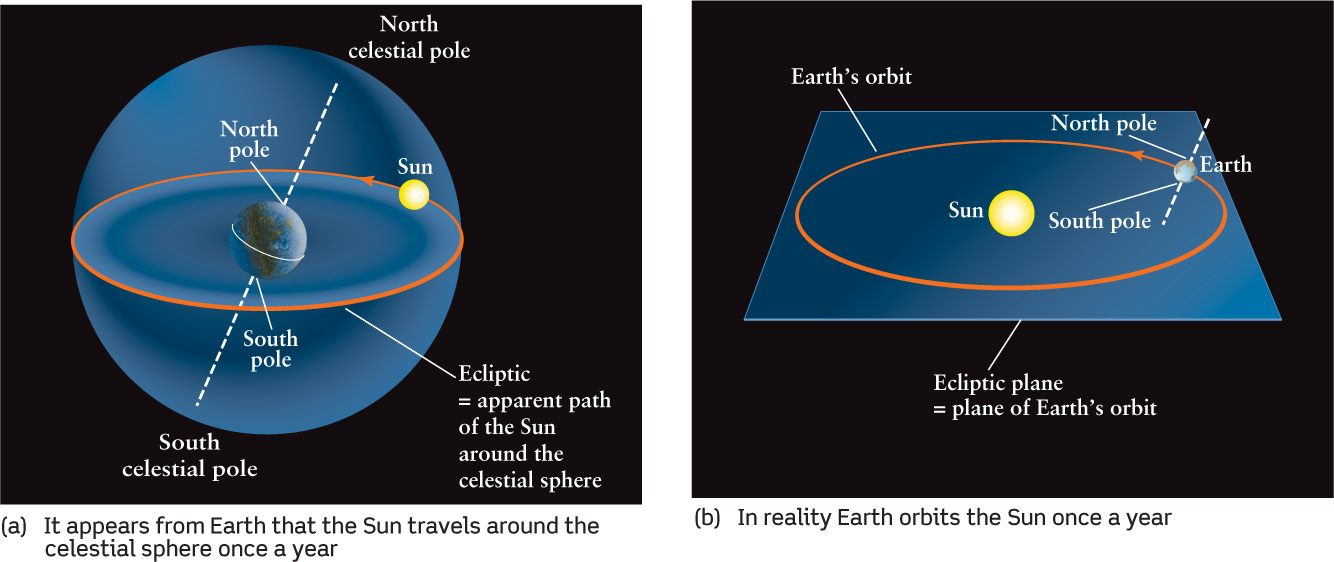
ANALOGY
Note that at the same time that the Sun is making its yearlong trip around the ecliptic, the entire celestial sphere is rotating around us once per day. You can envision the celestial sphere as a merry-go-round rotating clockwise, and the Sun as a restless child who is walking slowly around the merry-go-round’s rim in the counterclockwise direction. During the time it takes the child to make a round trip, the merry-go-round rotates 365¼ times.
The ecliptic plane is not the same as the plane of Earth’s equator, thanks to the 23½° tilt of Earth’s rotation axis, shown in Figure 1-14. As a result, the ecliptic and the celestial equator are inclined to each other by that same 23½° angle (Figure 1-17).
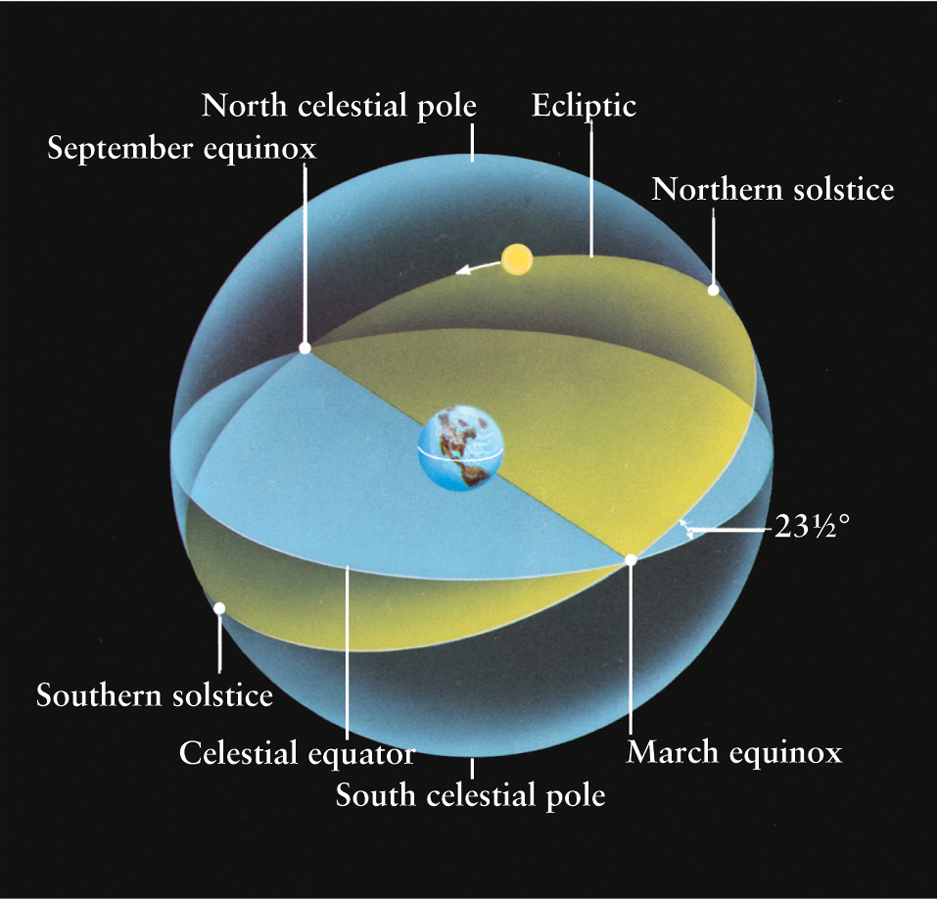
15
Question
ConceptCheck 1-7: How long does the Sun take to move from being next to a bright star, all the way around the celestial sphere, and back to that same bright star?
Equinoxes and Solstices
The ecliptic and the celestial equator intersect at only two points, which are exactly opposite each other on the celestial sphere (see Figure 1-17). Each point is called an equinox (Latin for “equal night”), because when the Sun appears to cover either of these points, day and night are each about 12 hours long at all locations on Earth. The term “equinox” is also used to refer to the date on which the Sun passes in front of one of these special points on the ecliptic.
On about March 21 of each year, the Sun crosses northward across the celestial equator at a point on the sky known as the March equinox. This marks the beginning of spring in the northern hemisphere (it was once known as the “vernal equinox,” from the Latin for “spring,” but we more often use the term March equinox because it is less Eurocentric). On about September 22 the Sun moves southward across the celestial equator at the September equinox, marking the moment when autumn (or fall) begins in the northern hemisphere. Since the seasons are opposite in the northern and southern hemispheres, for Australians and South Africans the March equinox actually marks the beginning of autumn.
16
Between the March and September equinoxes, two other significant locations lie along the ecliptic. The point on the ecliptic farthest north of the celestial equator is called the northern solstice. The word “solstice” is from the Latin for “solar standstill,” and it is at the northern solstice that the Sun stops moving northward on the celestial sphere. At this point, the Sun is as far north of the celestial equator as it can get. It marks the location of the Sun at the moment summer begins in the northern hemisphere—about June 21—and has traditionally been called the summer solstice, even though it marks the start of winter in the southern hemisphere. At the beginning of the northern hemisphere’s winter—about December 21—the Sun is farthest south of the celestial equator at a point called the southern solstice, which, again, has traditionally been known as the winter solstice, even though it marks the beginning of summer in the southern hemisphere.
Because the Sun’s position on the celestial sphere varies slowly over the course of a year, its daily path across the sky (due to Earth’s rotation) also varies with the seasons (Figure 1-18). On the first day of spring or the first day of autumn, when the Sun is at one of the equinoxes, the Sun rises directly in the east and sets directly in the west.
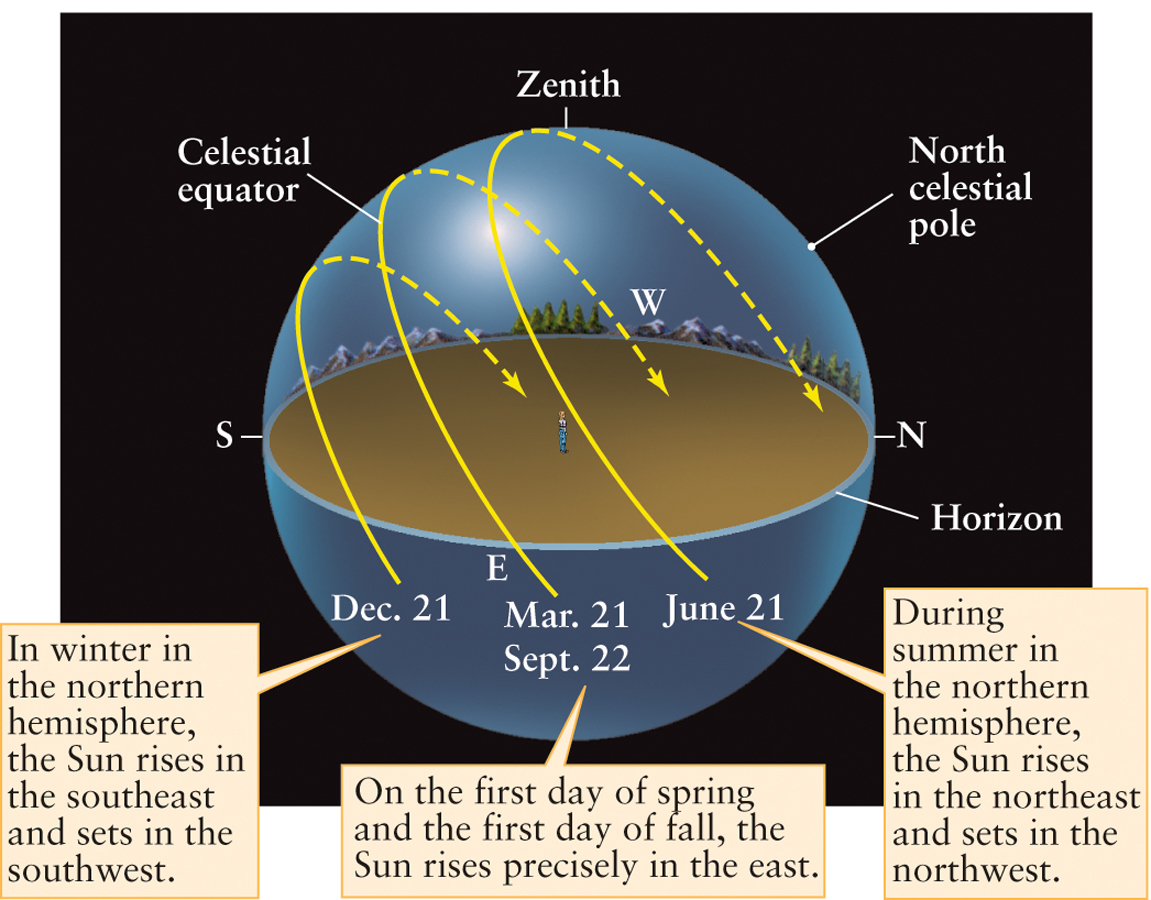
When the northern hemisphere is tilted away from the Sun and it is winter in the northern hemisphere, the Sun rises in the southeast. Daylight lasts for fewer than 12 hours as the Sun skims low over the southern horizon and sets in the southwest. Northern hemisphere nights are longest when the Sun is at the southern solstice.
If you were to travel from Earth’s equator toward the north pole, you would find that as you get farther north, the winter days get progressively shorter and the winter nights get progressively longer. In fact, anywhere within 23½° of Earth’s north pole (that is, north of latitude 90° − 23½° = 66½° north latitude), the Sun is below the horizon for 24 continuous hours at least one day of the year. The circle around Earth at 66½° north latitude is called the Arctic Circle (Figure 1-19). The corresponding region around the south pole is bounded by the Antarctic Circle at 66½° south latitude. At the time of the winter solstice, explorers south of the Antarctic Circle enjoy the “midnight sun,” or 24 hours of continuous daylight.
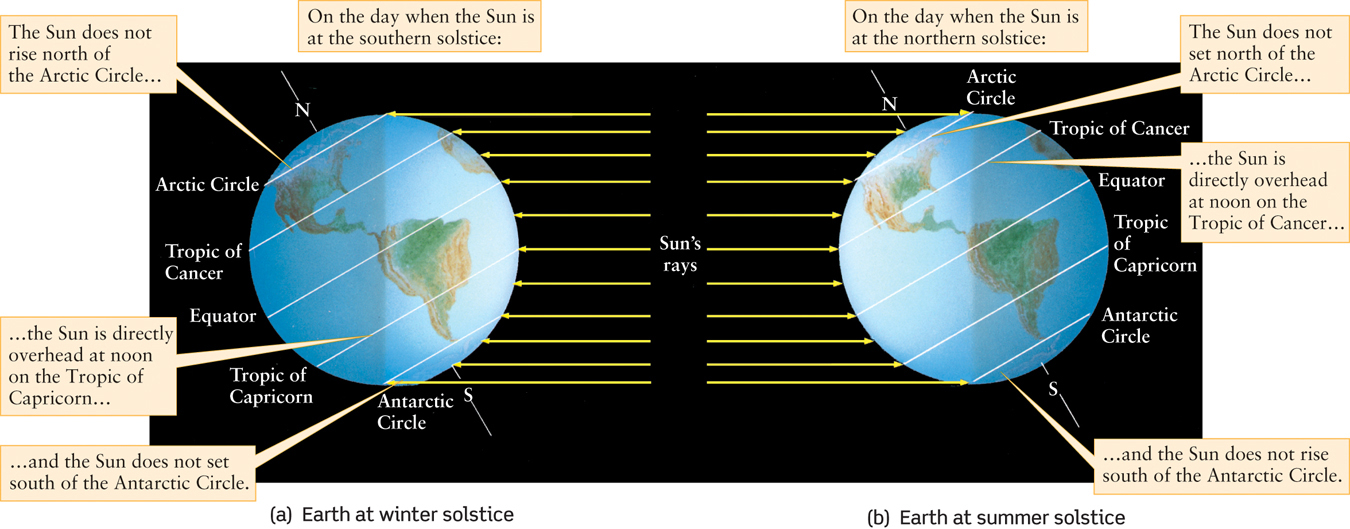
17
 Go to Video 1-3
Go to Video 1-3
The variations of the seasons are much less pronounced close to the equator. Between the Tropic of Capricorn at 23½° south latitude and the Tropic of Cancer at 23½° north latitude, the Sun is directly overhead—that is, at the zenith—at high noon at least one day a year. Outside of the tropics, the Sun is never directly overhead, but it is always either south of the zenith (as seen from locations north of the Tropic of Cancer) or north of the zenith (as seen from south of the Tropic of Capricorn).
Question
ConceptCheck 1-8: How often each year does an observer standing on Earth’s equator experience no shadow during the noontime Sun?
Question
CalculationCheck 1-2: Approximately how many days are there between the northern solstice and the March equinox?